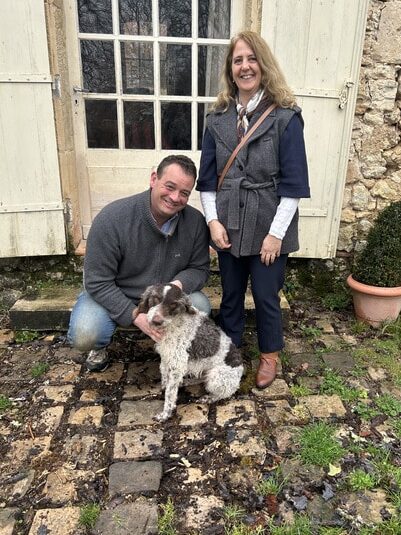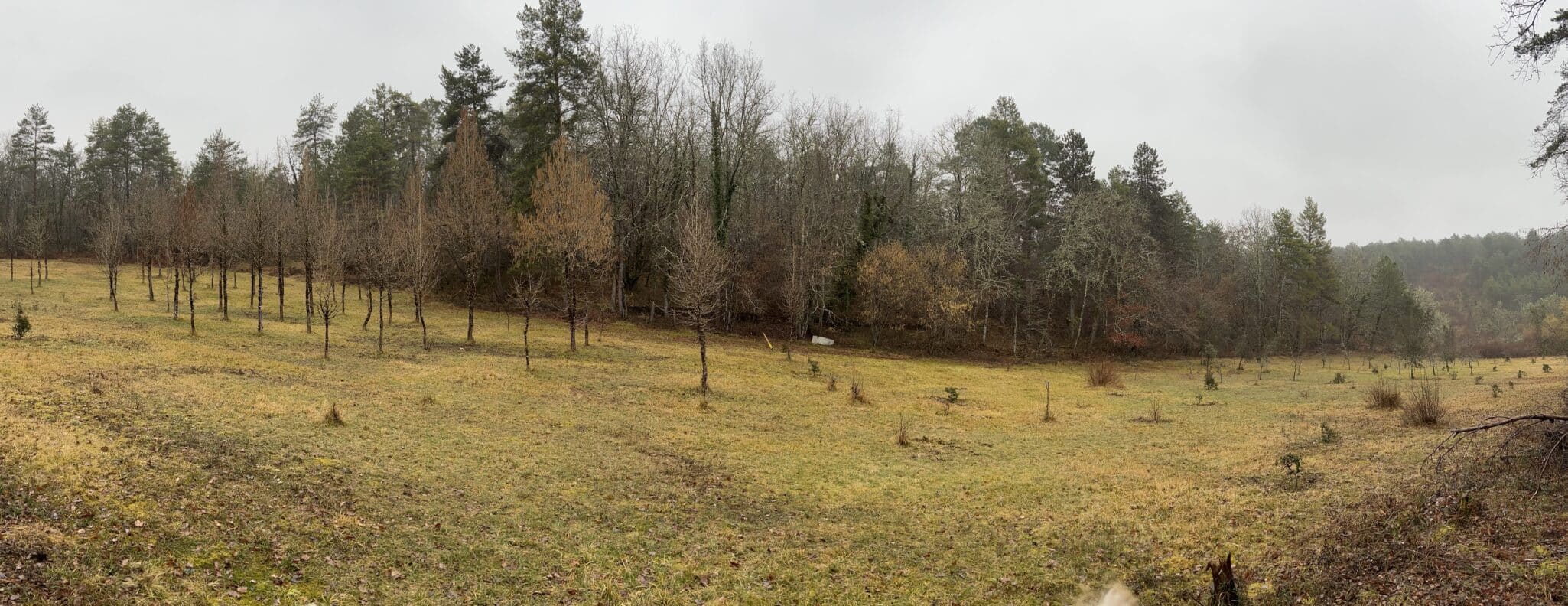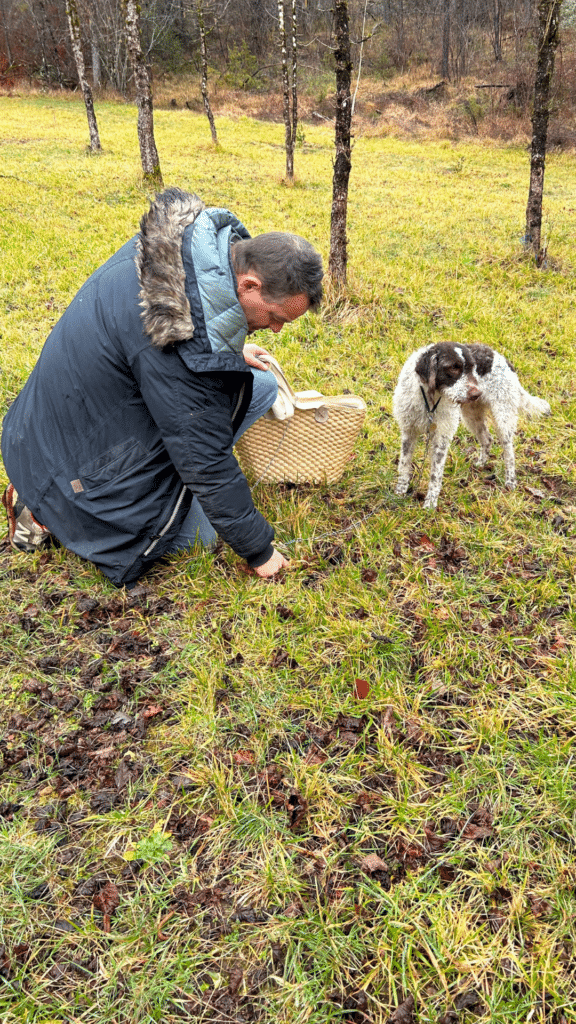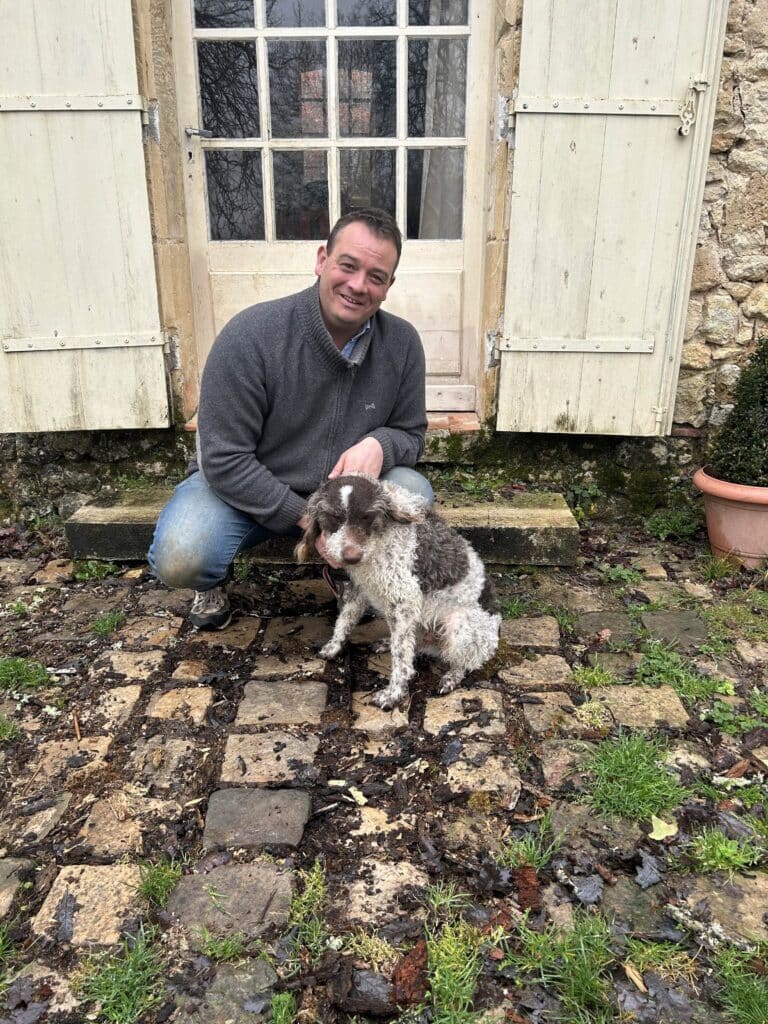The Dordogne region, known for its beautiful landscapes, its medieval character, its vineyards, the famous prehistoric caves of Lascaux, its castles and its gastronomy, is also the paradise of truffles. Real estate agent Kirsten Pollard has been working for more than 17 years in the real estate industry in the south-west of France and manages a mainly international clientele. Thanks to her great knowledge of the sector and her network, we were able to meet Xavier Mathiaud, professional truffle grower for 20 years . He has already accompanied some of our clients with their project to develop truffle farming on their land following their purchase of one of our prestigious châteaux.

Xavier, as a professional, how would you define your profession?
Being a truffle grower is a unique profession that combines geology, soil science, mycology, and agroforestry. It oscillates between rationality and magic.
How did your career as a truffle grower start?
It all started in January 2003. My father and my uncle had already been in the business for several years, and at that time we were picking truffles “à la mouche” (by observing where a particular fly sits). What struck me the day I picked up my first truffle was the scent that emanated from it. This one ignited a visceral passion in me. The “Cavage” (truffle hunting) is like a treasure hunt, only with a very special relationship to the earth. This magic that gripped me as soon as I picked up my first truffle inspired the project of helping new owners in the Dordogne in identifying potential areas for truffle growing.
What is the story behind the success of the truffle?
The first truffles would have appeared 12,000 years J.C, but truffle farming as we know it was born in France and Italy during the golden age of the 19th century. At that time, more than 1000 tons of truffles a year were harvested. At present, we harvest only between 60 and 80 tons per year. But truffle growing has only had its renaissance since the 1980s. Due to the rural exodus, production had fallen throughout the 20th century due to a loss of connoisseurs and knowledge. Being that the truffle is a jewel of French heritage, scientific research was launched to bring it back, and this is how we managed to decode the truffle genes by planting mycorrhized trees. As the experiments succeeded in the 80’s, it was in the 90’s that many started to bring truffle growing back. My father was one of the first to revive it. My uncle and I got back into “modern truffle farming”.
What is necessary to start in truffle farming? What factors are there that we don’t usually think of should be taken into account?
First of all, you have to call on an expert who will be able to diagnose whether the land is favorable for truffle growing or not. It is also necessary to have at least 2000m² of land minimum for it to be worthwhile. An average yield on good land, if the soil is well worked and the ecosystem favorable, generally takes between 5 to 10 years. As for full production, it takes between 10 and 15 years. I would say that to be a good truffle grower you need at least 20 years of experience.
Beyond the land itself, there are certain species that favour to the development of the truffle to take into account. The vine, for example, is one of them since it aerates the soil. In an old vineyard, we could keep one row out of 3 to plant truffle oaks without damaging the vine or the truffle. We can work on a landscaped truffle field by associating a dynamic landscaping with the truffle field for aesthetic truffle growing. It is a job that requires landscaper skills along with technical constraints.
It is important to know that it is absolutely not the size of the tree that counts. Even by remychorizing, maintaining the roots and aerating the soil, the truffle can grow on the one next to it. This is where all the magic of the truffle lies. A tree and a mushroom cannot live without each other, it is a symbiosis. Only the fungus will grow with the tree and others will not be able to compete.
It is the nurseries who sell the plants, and a certain number of protocols must be taken into account in order to certify that the plants are mycorrhized with the correct fungus.
In terms of personal qualities, I would say that you have to be humble, because you have to be patient. The truffle is capricious. You need to realise that each year is different from the previous one. Truffle farming happens under the ground, one can only assume. In my truffle field there is a completely burnt area where nothing grows. And yet a few days ago, my dog spotted a truffle there… It was the very first time that I had harvested one there. So, you have to expect everything, it’s an adventure full of surprises!

Why is the south-west of France such a promising area for truffles?
Historically in the 19th century, truffles developed in Dordogne, Lot, Touraine and Provence. François 1er also consumed Touraine truffles. Now truffles are growing in other regions. Over the past 15 years, competition between regions has developed due to climatic conditions favoring the development of truffles on new lands. The Dordogne is much less wooded than in the past, because under Louis XIV’s reign the consumption of wood was significant. The truffle needs air and light. The soils in the Dordogne are very poor and calcareous soils therefore very favorable to our well-known “black gold”.
Is it true that the Périgord truffle is considered the best in the world? If yes, why ?
What makes the Périgord truffle, also called tuber-melanosporum, famous is its fragrance. Indeed, the truffle is consumed as a perfume, delicately impregnating our recipes. It is the olfactory density that makes it rich. The melanosporum variety is the one that grows mainly in our region. However, one of the truffles with a surprising olfactory density, is the white alba truffle from Italy. Today, we have succeeded in decoding the genome of the latter and it is therefore also possible to embark on the truffle cultivation of Italian white truffles.
When is truffle season?
The truffle season is from December to the end of February. It takes 9 months between the fertilization of the truffle, usually starting in May. Subsequently, it grows during the summer and takes on its maturity and its perfume in the winter. This is why the truffle market starts at the beginning of December. Each of the truffles is qualified and validated by a professional a few hours before the opening of the market. Shortly after the market opens, the truffles are almost sold out. Everything goes at an incredible speed. I would qualify the truffle world as folkloric.
What criteria should be taken into account for a person wishing to invest in a property in the region with the aim of starting truffle farming?
First of all, it is of course necessary to have a favorable ground. In general, there is always some favorable ground on 20 hectares of land in our region. But you have to be careful because many terrains are very acidic. The Périgord Noir, for example, has a lot of wild truffle fields. Investing in a multi-hectare property there is often a winning combo. A truffle grower will be able to identify with a shovel if the ground is favorable. But scientific analyses are also necessary to validate the ability of the land to grow truffles.

Traditionally, truffle pigs are used for truffle hunting. However, at present it seems that dogs are more commonly used. Why is that ? What is the best truffle ally for a truffle grower?
In the 19th century, it was naturally easier to go truffle hunting with a pig than with a dog. It is the females that were used, because they have a chemical and physical attraction for the truffle, as it gives off the same smell as the male pig hormone. That’s why pigs are faster than a dog. But the attraction is so great that the pigs eat the truffle. Today it is very rare that truffle pigs are used. All dogs can smell truffles, but the Lagotto Romagnolo, a dog from Italy, is ideal for truffle hunting because it is very sensitive to the scent of truffles, enjoying it enormously. For my part, I adopted my first Lagotto in 2006 even before its success. My dog Rigo is very efficient at truffle hunting, but has some concentration problems. This is why it is necessary to adapt the technique and the relationship with your dog according to the relationship of the dog to the truffle. Everything is a game of balance between the relationship and training. Some dogs are up and running right away while others require more time.

If you wish to sell or invest in the wonderful region of Dordogne, our agent Kirsten Pollard is at your disposal to accompany you in your search for the ideal property.
We thank Xavier Mathiaud for receiving us and for sharing his passion, which did not leave us indifferent.
In the company of our agents and in collaboration with Xavier Mathiaud, our team at Maxwell-Baynes Christie’s International Real Estate will be delighted to accompany you from the beginning to the end of your project, from the acquisition of an outstanding property to the planning, development and layout of your future truffle plantation.
Article written by Caroline Mudrack
